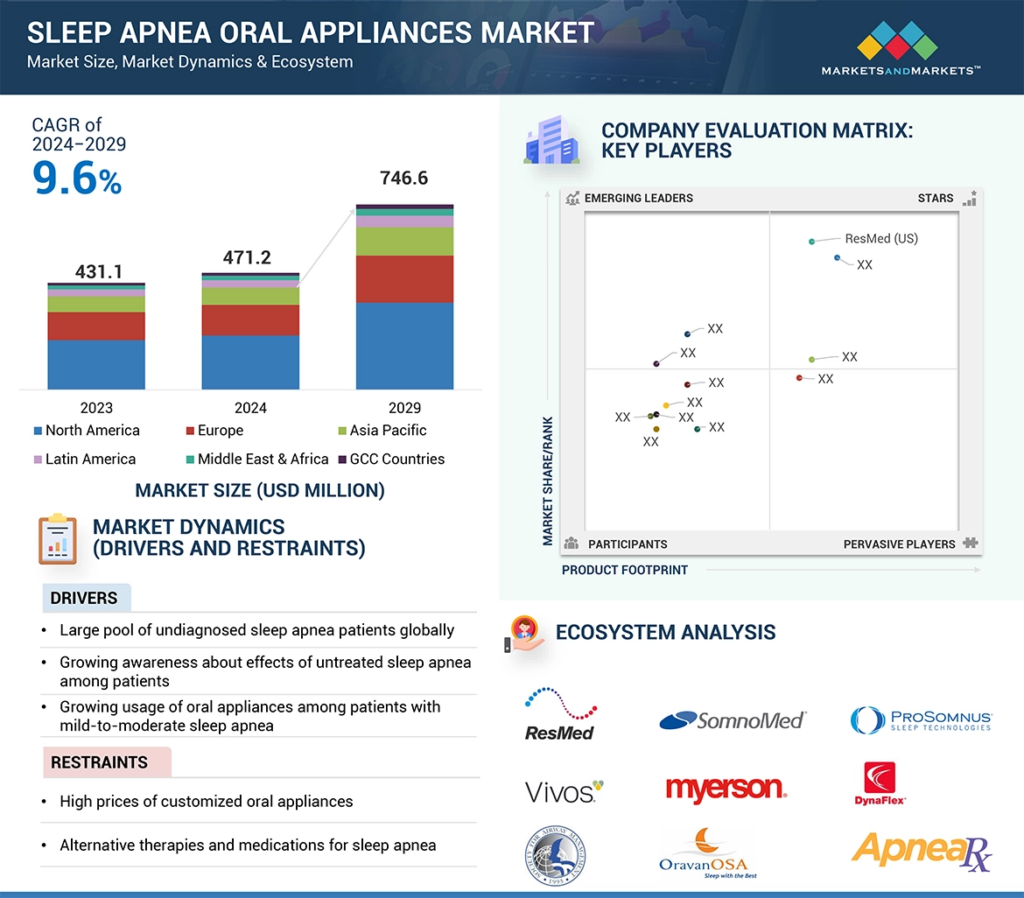The sleep apnea oral appliances market is experiencing significant growth, driven by increasing awareness of sleep disorders and advancements in treatment options. As of 2024, the global market is projected to reach USD 746.6 million by 2029, up from USD 471.2 million in 2024, reflecting a compound annual growth rate (CAGR) of 9.6%.

Key Market Drivers
- Large Pool of Undiagnosed Sleep Apnea Patients: A significant number of individuals worldwide remain undiagnosed for sleep apnea due to insufficient screening practices and low awareness. Studies indicate that around a billion people aged 30-69 have mild to severe obstructive sleep apnea, highlighting a substantial opportunity for diagnosis and treatment.
- Growing Awareness of Untreated Sleep Apnea Effects: There is an increasing understanding of the health risks associated with untreated sleep apnea, such as high blood pressure and ischemic heart disease. This awareness is driving more patients to seek diagnosis and treatment options, including oral appliances.
- Rising Number of Companies in the Sleep Apnea Devices Market: The market is witnessing an influx of companies developing innovative sleep apnea devices and oral appliances, contributing to market growth and offering patients a wider range of treatment options.
Market Restraints
- High Prices of Customized Oral Appliances: The cost of customized oral appliances can be prohibitive for some patients, limiting accessibility and adoption rates.
- Alternative Therapies and Medications: The availability of alternative treatments and medications for sleep apnea presents competition to oral appliances, potentially affecting market growth.
Opportunities
- Growing Demand for Home Sleep Apnea Tests: As a cost-saving measure, there is an increasing demand for home sleep apnea tests, which can facilitate earlier diagnosis and treatment initiation.
- Increasing Focus on Telemedicine, mHealth, and AI: The integration of telemedicine, mobile health applications, and artificial intelligence into sleep apnea management offers opportunities for improved patient monitoring and personalized treatment plans.
Regional Insights
- North America: The North American sleep apnea oral appliances market is projected to reach USD 350.8 million by 2029, growing at a CAGR of 9.9%. Factors contributing to this growth include a high prevalence of sleep apnea, advanced healthcare infrastructure, and increased awareness of sleep disorders.
- Asia Pacific: Expected to grow at the highest CAGR of 10.4% during the forecast period, the Asia Pacific market’s expansion is driven by a rising prevalence of sleep apnea, higher rates of obesity, and an increasing number of sleep and dental clinics.
Competitive Landscape
The market is characterized by a growing number of companies offering sleep apnea oral appliances. This increase in market participants is facilitating the development of innovative products and expanding treatment options for patients.
Conclusion
The sleep apnea oral appliances market is poised for substantial growth, driven by increased awareness, technological advancements, and a rising number of market participants. However, challenges such as high costs and competition from alternative therapies persist. Stakeholders should focus on leveraging emerging opportunities, such as home sleep tests and digital health integrations, to navigate the evolving landscape and meet patient needs effectively.
